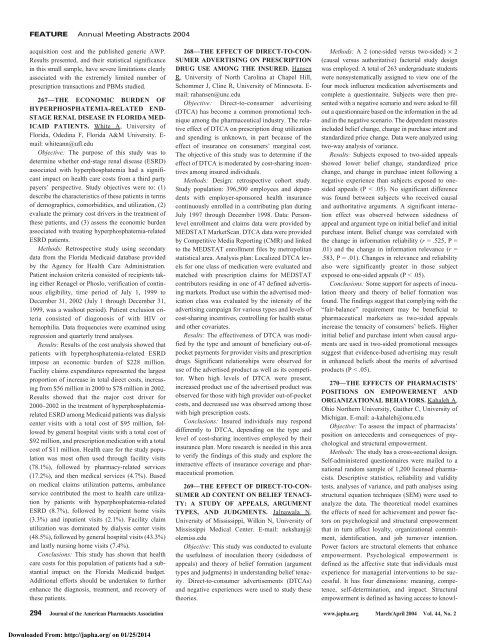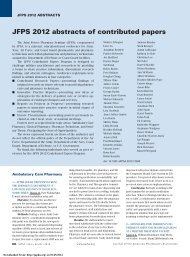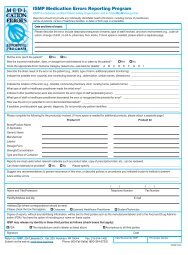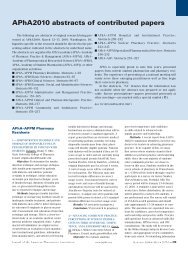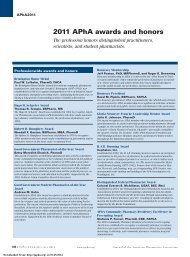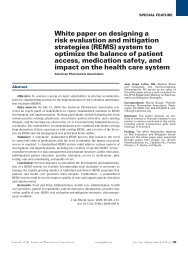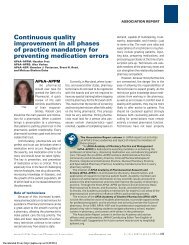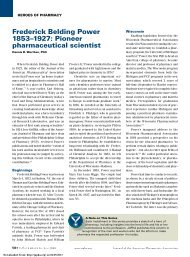Downloaded - Journal of American Pharmacists Association
Downloaded - Journal of American Pharmacists Association
Downloaded - Journal of American Pharmacists Association
Create successful ePaper yourself
Turn your PDF publications into a flip-book with our unique Google optimized e-Paper software.
FEATURE Annual Meeting Abstracts 2004<br />
acquisition cost and the published generic AWP.<br />
Results presented, and their statistical significance<br />
in this small sample, have severe limitations clearly<br />
associated with the extremely limited number <strong>of</strong><br />
prescription transactions and PBMs studied.<br />
267—THE ECONOMIC BURDEN OF<br />
HYPERPHOSPHATEMIA-RELATED END-<br />
STAGE RENAL DISEASE IN FLORIDA MED-<br />
ICAID PATIENTS. White A, University <strong>of</strong><br />
Florida, Odedina F, Florida A&M University. E-<br />
mail: whiteann@ufl.edu<br />
Objective: The purpose <strong>of</strong> this study was to<br />
determine whether end-stage renal disease (ESRD)<br />
associated with hyperphosphatemia had a significant<br />
impact on health care costs from a third party<br />
payers’ perspective. Study objectives were to: (1)<br />
describe the characteristics <strong>of</strong> these patients in terms<br />
<strong>of</strong> demographics, comorbidities, and utilization, (2)<br />
evaluate the primary cost drivers in the treatment <strong>of</strong><br />
these patients, and (3) assess the economic burden<br />
associated with treating hyperphosphatemia-related<br />
ESRD patients.<br />
Methods: Retrospective study using secondary<br />
data from the Florida Medicaid database provided<br />
by the Agency for Health Care Administration.<br />
Patient inclusion criteria consisted <strong>of</strong> recipients taking<br />
either Renagel or Phoslo, verification <strong>of</strong> continuous<br />
eligibility, time period <strong>of</strong> July 1, 1999 to<br />
December 31, 2002 (July 1 through December 31,<br />
1999, was a washout period). Patient exclusion criteria<br />
consisted <strong>of</strong> diagonosis <strong>of</strong> with HIV or<br />
hemophilia. Data frequencies were examined using<br />
regression and quarterly trend analyses.<br />
Results: Results <strong>of</strong> the cost analysis showed that<br />
patients with hyperphosphatemia-related ESRD<br />
impose an economic burden <strong>of</strong> $228 million.<br />
Facility claims expenditures represented the largest<br />
proportion <strong>of</strong> increase in total direct costs, increasing<br />
from $56 million in 2000 to $78 million in 2002.<br />
Results showed that the major cost driver for<br />
2000–2002 in the treatment <strong>of</strong> hyperphosphatemiarelated<br />
ESRD among Medicaid patients was dialysis<br />
center visits with a total cost <strong>of</strong> $95 million, followed<br />
by general hospital visits with a total cost <strong>of</strong><br />
$92 million, and prescription medication with a total<br />
cost <strong>of</strong> $11 million. Health care for the study population<br />
was most <strong>of</strong>ten used through facility visits<br />
(78.1%), followed by pharmacy-related services<br />
(17.2%), and then medical services (4.7%). Based<br />
on medical claims utilization patterns, ambulance<br />
service contributed the most to health care utilization<br />
by patients with hyperphosphatemia-related<br />
ESRD (8.7%), followed by recipient home visits<br />
(3.3%) and inpatient visits (2.1%). Facility claim<br />
utilization was dominated by dialysis center visits<br />
(48.5%), followed by general hospital visits (43.3%)<br />
and lastly nursing home visits (7.4%).<br />
Conclusions: This study has shown that health<br />
care costs for this population <strong>of</strong> patients had a substantial<br />
impact on the Florida Medicaid budget.<br />
Additional efforts should be undertaken to further<br />
enhance the diagnosis, treatment, and recovery <strong>of</strong><br />
these patients.<br />
268—THE EFFECT OF DIRECT-TO-CON-<br />
SUMER ADVERTISING ON PRESCRIPTION<br />
DRUG USE AMONG THE INSURED. Hansen<br />
R, University <strong>of</strong> North Carolina at Chapel Hill,<br />
Schommer J, Cline R, University <strong>of</strong> Minnesota. E-<br />
mail: rahansen@unc.edu<br />
Objective: Direct-to-consumer advertising<br />
(DTCA) has become a common promotional technique<br />
among the pharmaceutical industry. The relative<br />
effect <strong>of</strong> DTCA on prescription drug utilization<br />
and spending is unknown, in part because <strong>of</strong> the<br />
effect <strong>of</strong> insurance on consumers’ marginal cost.<br />
The objective <strong>of</strong> this study was to determine if the<br />
effect <strong>of</strong> DTCA is moderated by cost-sharing incentives<br />
among insured individuals.<br />
Methods: Design: retrospective cohort study.<br />
Study population: 396,500 employees and dependents<br />
with employer-sponsored health insurance<br />
continuously enrolled in a contributing plan during<br />
July 1997 through December 1998. Data: Personlevel<br />
enrollment and claims data were provided by<br />
MEDSTAT MarketScan. DTCA data were provided<br />
by Competitive Media Reporting (CMR) and linked<br />
to the MEDSTAT enrollment files by metropolitan<br />
statistical area. Analysis plan: Localized DTCA levels<br />
for one class <strong>of</strong> medication were evaluated and<br />
matched with prescription claims for MEDSTAT<br />
contributors residing in one <strong>of</strong> 47 defined advertising<br />
markets. Product use within the advertised medication<br />
class was evaluated by the intensity <strong>of</strong> the<br />
advertising campaign for various types and levels <strong>of</strong><br />
cost-sharing incentives, controlling for health status<br />
and other covariates.<br />
Results: The effectiveness <strong>of</strong> DTCA was modified<br />
by the type and amount <strong>of</strong> beneficiary out-<strong>of</strong>pocket<br />
payments for provider visits and prescription<br />
drugs. Significant relationships were observed for<br />
use <strong>of</strong> the advertised product as well as its competitor.<br />
When high levels <strong>of</strong> DTCA were present,<br />
increased product use <strong>of</strong> the advertised product was<br />
observed for those with high provider out-<strong>of</strong>-pocket<br />
costs, and decreased use was observed among those<br />
with high prescription costs.<br />
Conclusions: Insured individuals may respond<br />
differently to DTCA, depending on the type and<br />
level <strong>of</strong> cost-sharing incentives employed by their<br />
insurance plan. More research is needed in this area<br />
to verify the findings <strong>of</strong> this study and explore the<br />
interactive effects <strong>of</strong> insurance coverage and pharmaceutical<br />
promotion.<br />
269—THE EFFECT OF DIRECT-TO-CON-<br />
SUMER AD CONTENT ON BELIEF TENACI-<br />
TY: A STUDY OF APPEALS, ARGUMENT<br />
TYPES, AND JUDGMENTS. Jalnawala N,<br />
University <strong>of</strong> Mississippi, Wilkin N, University <strong>of</strong><br />
Mississippi Medical Center. E-mail: nekshanj@<br />
olemiss.edu<br />
Objective: This study was conducted to evaluate<br />
the usefulness <strong>of</strong> inoculation theory (sidedness <strong>of</strong><br />
appeals) and theory <strong>of</strong> belief formation (argument<br />
types and judgments) in understanding belief tenacity.<br />
Direct-to-consumer advertisements (DTCAs)<br />
and negative experiences were used to study these<br />
theories.<br />
Methods: A 2 (one-sided versus two-sided) × 2<br />
(causal versus authoritative) factorial study design<br />
was employed. A total <strong>of</strong> 263 undergraduate students<br />
were nonsystematically assigned to view one <strong>of</strong> the<br />
four mock influenza medication advertisements and<br />
complete a questionnaire. Subjects were then presented<br />
with a negative scenario and were asked to fill<br />
out a questionnaire based on the information in the ad<br />
and in the negative scenario. The dependent measures<br />
included belief change, change in purchase intent and<br />
standardized price change. Data were analyzed using<br />
two-way analysis <strong>of</strong> variance.<br />
Results: Subjects exposed to two-sided appeals<br />
showed lower belief change, standardized price<br />
change, and change in purchase intent following a<br />
negative experience than subjects exposed to onesided<br />
appeals (P < .05). No significant difference<br />
was found between subjects who received causal<br />
and authoritative arguments. A significant interaction<br />
effect was observed between sidedness <strong>of</strong><br />
appeal and argument type on initial belief and initial<br />
purchase intent. Belief change was correlated with<br />
the change in information reliability (r = .525, P =<br />
.01) and the change in information relevance (r =<br />
.583, P = .01). Changes in relevance and reliability<br />
also were significantly greater in those subject<br />
exposed to one-sided appeals (P < .05).<br />
Conclusions: Some support for aspects <strong>of</strong> inoculation<br />
theory and theory <strong>of</strong> belief formation was<br />
found. The findings suggest that complying with the<br />
“fair-balance” requirement may be beneficial to<br />
pharmaceutical marketers as two-sided appeals<br />
increase the tenacity <strong>of</strong> consumers’ beliefs. Higher<br />
initial belief and purchase intent when causal arguments<br />
are used in two-sided promotional messages<br />
suggest that evidence-based advertising may result<br />
in enhanced beliefs about the merits <strong>of</strong> advertised<br />
products (P < .05).<br />
270—THE EFFECTS OF PHARMACISTS’<br />
POSITIONS ON EMPOWERMENT AND<br />
ORGANIZATIONAL BEHAVIORS. Kahaleh A,<br />
Ohio Northern University, Gaither C, University <strong>of</strong><br />
Michigan. E-mail: a-kahaleh@onu.edu<br />
Objective: To assess the impact <strong>of</strong> pharmacists’<br />
position on antecedents and consequences <strong>of</strong> psychological<br />
and structural empowerment.<br />
Methods: The study has a cross-sectional design.<br />
Self-administered questionnaires were mailed to a<br />
national random sample <strong>of</strong> 1,200 licensed pharmacists.<br />
Descriptive statistics, reliability and validity<br />
tests, analyses <strong>of</strong> variance, and path analyses using<br />
structural equation techniques (SEM) were used to<br />
analyze the data. The theoretical model examines<br />
the effects <strong>of</strong> need for achievement and power factors<br />
on psychological and structural empowerment<br />
that in turn affect loyalty, organizational commitment,<br />
identification, and job turnover intention.<br />
Power factors are structural elements that enhance<br />
empowerment. Psychological empowerment is<br />
defined as the affective state that individuals must<br />
experience for managerial interventions to be successful.<br />
It has four dimensions: meaning, competence,<br />
self-determination, and impact. Structural<br />
empowerment is defined as having access to knowl-<br />
294 <strong>Journal</strong> <strong>of</strong> the <strong>American</strong> <strong>Pharmacists</strong> <strong>Association</strong> www.japha.org March/April 2004 Vol. 44, No. 2<br />
<strong>Downloaded</strong> From: http://japha.org/ on 01/25/2014


